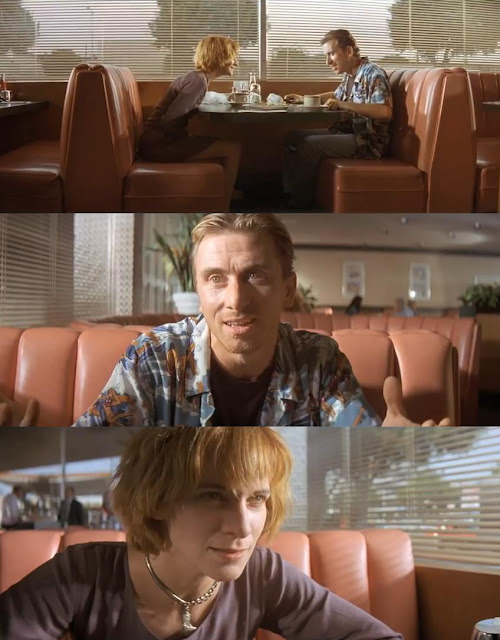Introduction to Pulp Fiction
Pulp Fiction (1994) by Quentin Tarantino is the film we are studying for Section D: Film Movements - Experimental Film (1960-2000) on the second exam paper Component 2: Global Filmmaking Perpectives.
In the exam you will answer one question from a choice of two. You should spend 30 minutes on your essay. The questions could be on one of the Core Areas of Study such as an aspect of film form (focusing on any of cinematography, mise-en-scene, editing, sound or performance), representation (of gender, ethnicity or age), aesthetics (the overall style and feel of the film), or contexts (social, cultural, political, institutional, economic or technological).
Alternatively, questions could be on the Specialist Study Areas for Section D: Film Movements - Experimental Film - testing your understanding of either narrative (the way that story information is constructed) or auteur (the control a director has over his or her work, shown through consistency in style and/or theme).
More information about these specialist study areas can be found by clicking on the links below. It is likely that one of the questions will be on a core study area whilst the second question will be on one of the specialist study areas - though it is perfectly possible both questions will be related to the specialist study areas (one on narrative and the other on auteur).
Remember that, regardless of the question, you must make explicit references to key scenes from Pulp Fiction to support your points.
When writing about Pulp Fiction it is important to remember that you must discuss it in the context of experimental film. Click on the link below to refresh your memory about this particular film movement.
An Introduction to Experimental Film
Arguably, Pulp Fiction is not so much a film as a phenomenon. Winning major prizes (the Palme d'Or at Cannes and the Oscar, the Bafta and the Golden Globe for Best Original Screenplay), giving rise to an immense culture of obsessive fandom (for both the movie itself and the film's director) and generating countless 'wannabe' movies, Pulp Fiction burst onto cinema screens in 1994 as an inescapable signpost of its age.
The film was praised and criticised in equal measure for its deliberately cool superficiality, with many detractors seeing the film as the embodiment of the empty postmodernity of the 1990s, with its stylish characters, its rejection of conventional narrative structure and its clever allusions to other works of popular culture.
The film arguably remains Tarantino's defining work. Its non-linear, fractured, circular narrative structure and atypical representations of both antagonists and protagonists, alongside its trademark script full of pop culture references and intertextuality, make it quintessential Tarantino (and therefore, the perfect film to use to discuss Tarantino as an auteur).
Tarantino announced his postmodern style with Reservoir Dogs (1992) and in his scripts for True Romance (1993) and Natural Born Killers (1994) but with Pulp Fiction he achieved mainstream success.
Of his body of work only Inglorious Basterds (2009), Django Unchained (2012) and Once Upon a Time in Hollywood (2019) have grossed more than Pulp Fiction at the worldwide box-office.
Pulp Fiction was the first American Independent film to earn over $100 million at the USA box-office and heralded the arrival of Indiewood as a production phenomenon (films made independently, outside of the Hollywood Studio System, but which had bigger budgets than traditional independent films, were marketed and sold to audiences in much the same way that Hollywood films are and which often starred A-list actors and received wider, multiplex releases).
Arguably, Pulp Fiction is not so much a film as a phenomenon. Winning major prizes (the Palme d'Or at Cannes and the Oscar, the Bafta and the Golden Globe for Best Original Screenplay), giving rise to an immense culture of obsessive fandom (for both the movie itself and the film's director) and generating countless 'wannabe' movies, Pulp Fiction burst onto cinema screens in 1994 as an inescapable signpost of its age.
The film was praised and criticised in equal measure for its deliberately cool superficiality, with many detractors seeing the film as the embodiment of the empty postmodernity of the 1990s, with its stylish characters, its rejection of conventional narrative structure and its clever allusions to other works of popular culture.
The film arguably remains Tarantino's defining work. Its non-linear, fractured, circular narrative structure and atypical representations of both antagonists and protagonists, alongside its trademark script full of pop culture references and intertextuality, make it quintessential Tarantino (and therefore, the perfect film to use to discuss Tarantino as an auteur).
Tarantino announced his postmodern style with Reservoir Dogs (1992) and in his scripts for True Romance (1993) and Natural Born Killers (1994) but with Pulp Fiction he achieved mainstream success.
Of his body of work only Inglorious Basterds (2009), Django Unchained (2012) and Once Upon a Time in Hollywood (2019) have grossed more than Pulp Fiction at the worldwide box-office.
Pulp Fiction was the first American Independent film to earn over $100 million at the USA box-office and heralded the arrival of Indiewood as a production phenomenon (films made independently, outside of the Hollywood Studio System, but which had bigger budgets than traditional independent films, were marketed and sold to audiences in much the same way that Hollywood films are and which often starred A-list actors and received wider, multiplex releases).












Comments
Post a Comment